Equestrian vaulting: Italy’s disabled riders competing in horseback gymnastics
 BBC
BBCIt's five weeks until one of Italy's regional equestrian vaulting competition, and all eyes are on Antinisca Cenci who is hoping to snatch a prize.
Also preparing for her moment in the spotlight is eight-year-old Beatrice, but in the tense run up to the competition, there are concerns over whether she'll be ready in time.
They both attend La Fenice, just outside Verona - an association set up in 2001 which trains disabled people, as well as those who are non-disabled, in equestrian vaulting.
Equestrian vaulting is often described as gymnastics on horseback.
It has a recent history of being performed in circuses, however, it's believed people have been doing acrobatic movements while riding moving horses for more than 2,000 years.
Now it's recognised by the International Federation for Equestrian Sports and competitions are held around the world.
It can also be a form of therapy for disabled people. Riding a horse, accompanied by rhythmic music and balance exercises, can help improve strength, co-ordination and mobility.
In Italy, vaulting was the first equestrian discipline to welcome disabled athletes to compete together with non-disabled riders. These are known as integrated categories and this year is the first year the Veneto regional championship has introduced them.
Antinisca, who has Down's syndrome, started equestrian vaulting in her 30s as part of a programme initiated by Italy's National Association for Families and People with Disabilities (ANFFAS).
She is now 45 years old and is training with a team which will take part in the Veneto championship.
She is one of the women featured on the BBC 100 Women list, which each year names 100 inspiring and influential women around the world.
ANFFAS teamed up with La Fenice, where students learn equestrian vaulting from the best in the business.
Their trainers include World champion vaulter, Anna Cavallaro, and the man who trained her when she was a girl, Nelson Vidoni.
Anna Cavallaro discovered vaulting at the age of 11, when her dad took her to a riding school where Nelson taught.
She was hooked immediately.
"He put me on a horse and the following Saturday I was vaulting," Anna says.
The pair wrote history when Cavallaro became the first Italian to win the World Cup three times.
Following an injury, she no longer competes. Instead, she has dedicated her life to being a trainer.
"Now I teach what it means to vault, to love horses and to put all your passion into it," she says.
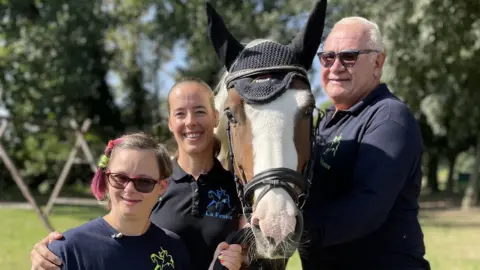
Nelson Vidoni, or "grandad" as he is affectionately called by his students, explains how the sport is beneficial for those who take part.
"The animal becomes a friend and that helps to improve co-ordination, self-esteem, finding balance and socialising," he says.
But he's also keen to show how focused he is on the sport's competitive aspect.
"I am very tough with them, even if afterwards I hug them," says Nelson. "People with disabilities need guidance too. It must be the same as with other people we train, there's no difference."
With everyone focusing firmly on the competition, it's Anna's job to make sure the team will be ready to perform.
Antinisca is looking ready to go, but it's not clear whether Beatrice will make the grade.
Nelson is adamant that he won't put anyone in a competition who he doesn't think is ready.
- BBC 100 Women names 100 inspiring and influential women around the world every year - Antinisca Cenci is on this year's list
- Meet this year's 100 Women here
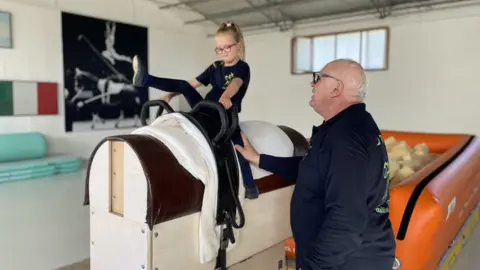
Beatrice, or Bea for short, arrived at La Fenice four years ago and immediately became passionate about the world of horses.
Anna has noticed that when Bea does routine exercises, she does them listlessly, without any sparkle.
"But when she freestyles, doing new exercises… she puts all her heart into it," she says.
Bea's mother, Alice, speaks about her daughter with a huge sense of pride.
She says Bea, who has Down's syndrome like Antinisca, achieves goals that she didn't think would be possible.
People said that Bea would never ride a bicycle alone, but now she goes off for long rides, Alice says.
She doesn't see Bea's Down's syndrome as a disability. "It's a characteristic. Nothing more," she says.
So, does her mother think Bea is ready for the Regionals?
"I'd like it," she says with a smile. "I'd be the one to cheer like crazy. I'm naturally very competitive."
But she concedes it's not her decision. It's for Nelson and Anna to decide.
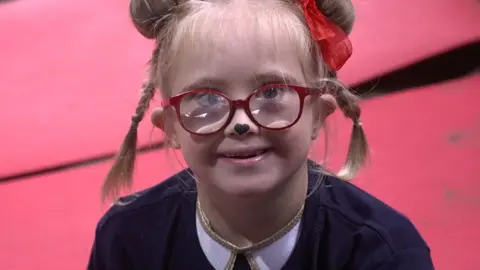
With one week to go until the competition the riders are undergoing their final training session.
They are used to practising on a mechanical horse, which is a non-motorised horse-shaped block controlled by the rider's movement. Now they are trying to perfect their moves for the freestyle routine on a real horse.
"You have go back a little with your shoulders," says Nelson as he gives Antinisca some final instructions. "Do you go forward with your shoulders and legs down? No," he commands.
Antinisca say she feels ready for the competition but admits she has some last minute nerves.
The day of the Veneto Regional competition has finally arrived and Antinisca and her vaulting team are huddled together in a corner of the indoor arena with horses and competitors milling around, discussing final details ahead of the performance.
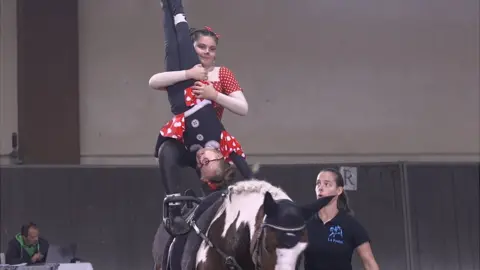
Bea can be seen warming up. Does that mean she is ready to compete?
Nelson confirms that he has given her the go ahead.
"It's a small success," says her mother. "I hope the first of many."
Dressed up as Minnie Mouse, in red and white polka dot clothes and hair in pigtails, Bea takes to the paddock alongside her vaulting partner.
The audience and other competitors watch closely as Bea begins her routine.
With Anna's assistance she mounts the horse gracefully and performs each move with a smile across her face that earns her a huge round of applause from the audience.
Bea's debut performance has been a success. She and her partner, Cecilia, win silver for their category.
Now it's Antinisca's turn with partners Michele and Alberto. She goes from mounting the horse to standing on it behind Michele, who sits in front of her. She then moves gracefully through their well-rehearsed gymnastic moves.
As they complete their routine there's another eruption of applause.
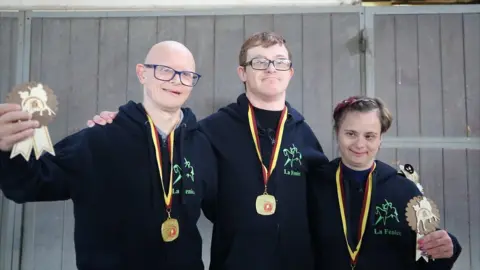
Is Antinisca happy with their performance? "Yes, very happy," she says.
The judges are also impressed, as they announce that the team has won the gold medal.


Balance, stamina and leotards: BBC 100 Women enters the world of disabled equestrian vaulting.


BBC 100 Women names 100 inspiring and influential women around the world every year. Follow BBC 100 Women on Instagram and Facebook. Join the conversation using #BBC100Women.
